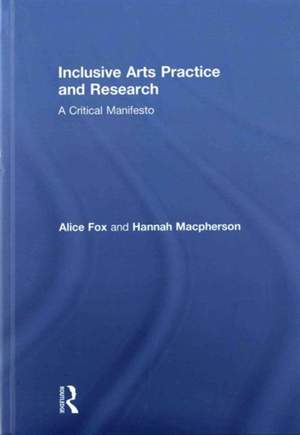Inclusive Arts Practice and Research: A Critical Manifesto
- Author: Fox, Alice
- Author: Macpherson, Hannah
Book
$183.50Printed on demand
Contents
- List of Illustrations
- Foreword
- Acknowledgements
- Chapter 1 Situating Inclusive Arts: aesthetics, politics, encounters
- Introduction
- What is Inclusive Arts?
- Why use the term Inclusive Arts?
- What sorts of inclusions occur through Inclusive Arts Practice?
- Learning disabilities, intellectual disabilities or learning difficulty? Some notes on terminology
- What contribution does Inclusive Art make to Contemporary Art?
- What are the potential aesthetic effects of Inclusive Arts?
- Is this Outsider art?
- How should work be labelled? If at all...
- How does this work relate to the everyday lives of people with learning disabilities?
- What are the transformative potentials of Inclusive Arts?
- So what is the difference between an Inclusive Artist and a community worker?
- Audience encounters 1: What can be achieved when audiences experience this work?
- Audience encounters 2: How does this work intervene in regimes of disabled visuality?
- Audience encounters 3: What can audiences take away from this work?
- How does Inclusive Arts differ from Disability Art?
- How does Inclusive Arts differ from art therapy and occupational therapy?
- What are the characteristics of good quality Inclusive Arts?
- What is in the rest of the book?
- A note from the authors...
- Paradox
- A note on editing interviews in Chapters Three and Four
- Accessible Summary
- Chapter 2 Curation, biography and audience encounter.................................................................41
- Introduction
- Diversity, encounter and exchange in the cultural sphere
- Alice Fox on Inclusive Curation: Putting on the 'Side by Side' exhibition at the Southbank
- Art and inclusion: what is shared with other artists and curators who are placed at 'the margins'?
- Jude Kelly, Artistic Director of the Southbank Centre, London
- Anna Cutler, Director of Learning at Tate
- Catherine Morris, Sackler Family Curator for the Elizabeth A. Sackler Center for Feminist Art at the Brooklyn Museum, NY.
- Conclusions: productive difference, performative interpretation and an emphasis on unknowability
- Chapter 3 How do we practice Inclusive Arts? .............................................................................85
- Introduction
- Frameworks, foundations, timetables and starting points
- Choice and Freedom
- Time
- Trust
- Risk and Uncertainty
- An openness to all the languages we communicate in
- An embodied ethic of encounter
- Becoming a self aware practitioner
- The answers are in the room
- Interviews with the Rockets
- Rocket artists: a conversation about the Wedding Cloaks
- Jane Fox, Louella Forest and Alice Fox
- Conclusions
- Chapter 4 Interviews with the artists..........................................................................................115
- Dean Rodney and Mark Williams, Heart and Soul, London
- Declan Byrne and Andrew Pike, The Kilkenny Collective for Arts Talent (KCAT), Ireland
- Kate Adams, Project Art Works
- Charlotte Hollinshead, Action Space, London
- Bethan Kendrick and Jacobus Flynn, Corali Dance Company, London
- Chapter 5 Inclusive Arts Research...........................................................................................159
- Introduction
- Inclusive Arts Practice as a form of research: making meaning through artistic forms of inquiry
- Research terminology
- Who or what is the subject of Inclusive Arts Research?
- What constitutes a literature review in Inclusive Arts research?
- What are the methods of Inclusive Arts research?
- Being a reflexive (self-aware) research practitioner
- What are the possible findings of Inclusive Arts Research?
- Research on Inclusive Arts: interpretation, definition and classification
- Evaluating the success of your project
- Thinking about social impact and cultural value
- A few starting points for Inclusive Arts research
- Research Project Ethics
- Context
- Informed Consent
- Free from Coercion
- Your research 'outputs' and intended audiences
- Chapter 6 The Future of Inclusive Arts: building a global movement...................................................195
- Introduction
- What would you hope for the future of Inclusive Arts?
- What is the future for learning disabled arts education?
- How can learning disabled artists go professional?
- What is the significance of Inclusive Arts for all and how can support worker 'buy in' be ensured?
- How can Inclusive Art help advance the human rights of people with learning disabilities and achieve social justice?
- The Central Human Capabilities (Adapted from Nussbaum 2003)
- How can Inclusive Art work explore themes such as sex, sexuality, nudity and death?
- Chapter 7 The making of this book................................................................................224
- Who made this book and why?
- How was this book made?
- Afterword




